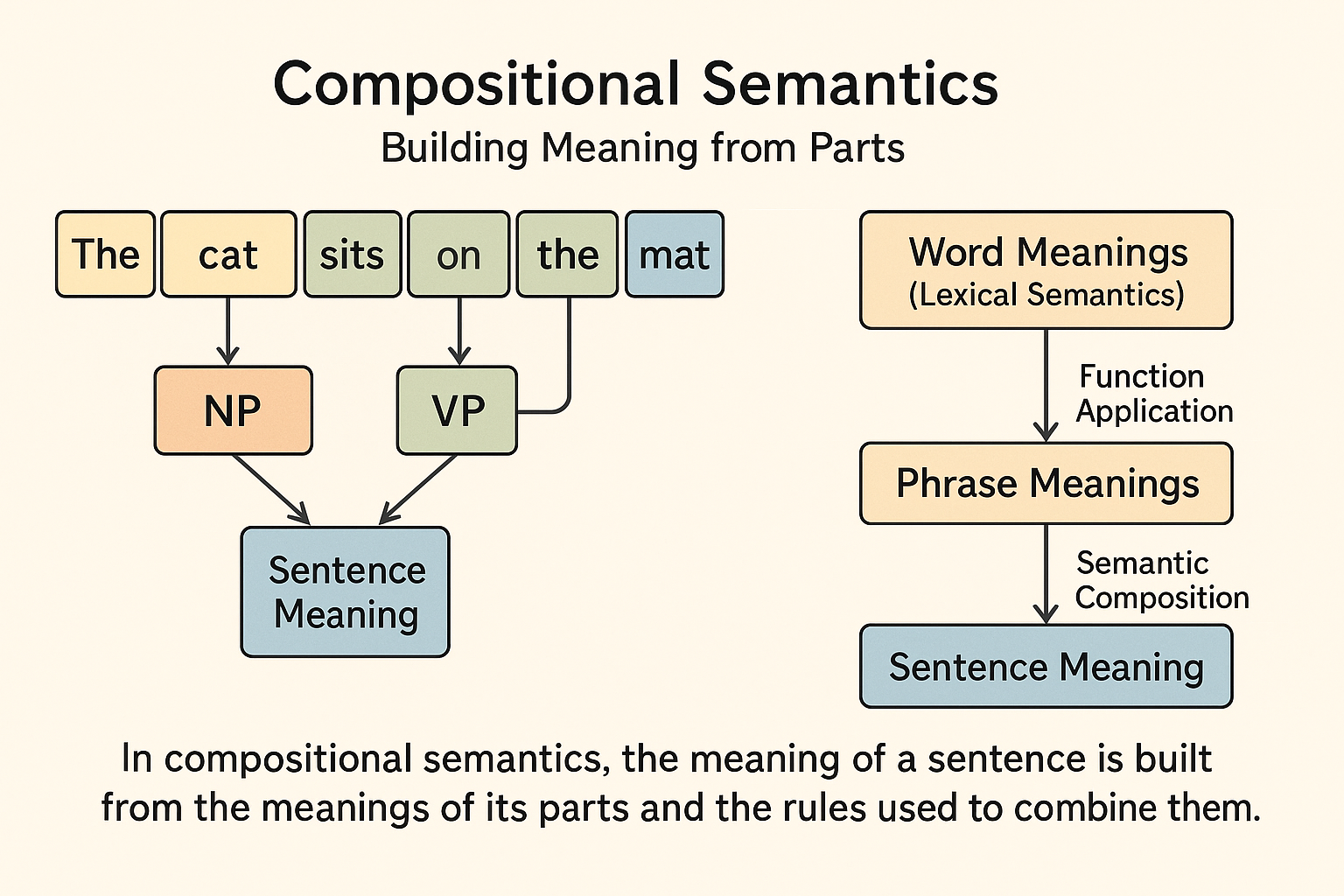Compositional Semantics Meaning

In both linguistic semantics and Natural Language Processing (NLP), compositional semantics is a key idea. The way that the meaning of a broader language expression is constructed from the meanings of its component elements is its primary interest.
Frege’s Principle, sometimes referred to as the Principle of Compositionality, serves as the foundation for this strategy. According to this theory, the syntactic combination of the parts and their respective meanings determine the meaning of the whole. This suggests a recursive way to calculate the meaning of a complicated phrase, offering a helpful relationship between syntax and semantics.
Practically speaking, this means that compositional semantics depends on a previous syntactic study to ascertain a sentence’s structure. According to this syntactic analysis, the “constituent parts” are usually noun phrases (NP) and verb phrases (VP). The way these elements are syntactically integrated determines how their separate meanings are put together to form the meaning of the whole.
A common comparison between compositional semantics and lexical semantics is that the former emphasises the meaning of individual words or fixed word combinations. The meanings of lexical elements are frequently taken for granted or left unquestioned in compositional techniques, making them the foundation for the process of creating meaning. Nonetheless, there is growing recognition of the interaction between grammatical/compositional semantics and word-level semantics.
Example: Compositional semantics is seen in “Very beautiful girl”. The phrase’s meaning comes from its elements (“very,” “beautiful,” and “girl”) and their grammatical combination. “Very” emphasises “beautiful,” which characterises the “girl”.
Parts and their Meanings:
- “Very”: This adverb intensifies the degree of the adjective that follows it. In this case, it makes the quality of “beautiful” more extreme.
- “Beautiful”: This adjective describes someone who is pleasing to look at or admire, conveying a sense of aesthetic appeal.
- “Girl”: This noun refers to a female child or young woman.
Compositional Semantics Approaches
There are several approaches that are employed to compose and depict meanings:
- It is common to use logic to convey meaning.
- For a completely appropriate representation, first-order logic (FOPC), which permits negation and inference, is regarded as a minimal prerequisite. However, because comprehensive FOPC requires probabilistic reasoning and collecting extensive domain knowledge is difficult, it has proven difficult to construct practical systems based on it. The fact that FOPC requires quantifiers to have particular scopal links that aren’t always obvious in regular language is another drawback.
- Using the λ-calculus to combine logical expressions is a widespread practice. Because of this, anonymous functions may be represented and functional application is made possible. This means that the meaning of one element (like a VP) can be applied as a function to the meaning of another (like an NP) to determine the meaning of their combination (like a S).
- Function application can be validated and compositional analysis supported by type systems that provide types such as ‘entities’ (e) and ‘truth values’ (t).
- A sentence’s logical form is the term used to describe the ensuing semantic representation.
- One important objective is to integrate syntactic parsing with semantic creation. Alongside syntactic structures, grammar approaches are intended to construct semantic representations:
- In order to construct meanings, feature-based and feature-structure grammars can employ methods such as unification and supplement lexical entries and rules with semantic information.
- For compositional semantic analysis, it is proposed that Combinatory Categorial Grammar (CCG) is especially well-suited. It makes use of a collection of complicated categories (types) and combinatorial operations that serve as functions.
- Bottom-up parsing algorithms such as CKY can determine the optimal semantic analysis by breaking down scoring techniques for semantic analyses across syntactic-semantic outputs. Linking is another term for the connection between syntax and semantics in lexical items.
Compositional Semantics Challenges
Compositional semantics is strong, but it has drawbacks:
- Semantic underspecification, like quantifier scope ambiguity, is a significant problem that basic compositional principles cannot directly address. This is addressed by methods like Hole semantics and Cooper storage.
- It takes more intricate models, such as dynamic semantics, to extend formal semantics to multi-sentence texts.
- Simple compositionality may be hampered by multiword expressions (MWEs), whose meaning may not always be clear from their constituent parts.
- Getting the lexicon’s comprehensive semantic information and handling the inference’s complexity are still major challenges, especially for broad-coverage processing. In reality, lexical semantic linkages that are shallower and more broad are now more beneficial.
Notwithstanding these difficulties, compositional semantics is essential to computational semantics and applies to a number of NLP tasks, such as semantic parsing. It serves as the foundation for methods that seek to relate language to outside information or world models (Model-theoretic semantics), and it is being investigated in conjunction with distributional semantics, for example, in compositional vector grammars. Since figuring out the right meaning of individual words (also known as “the meanings of the parts”) is crucial to creating the meaning of the whole, Word Sense Disambiguation (WSD) is a crucial first step. Predicate-argument semantics discusses the roles arguments play in respect to a predicate, and semantic roles are a related subfield of this field.
